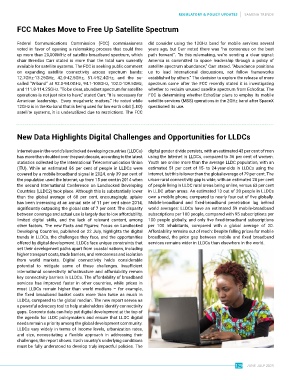Page 129 - SAMENA Trends - June-July 2025
P. 129
REGULATORY & POLICY UPDATES SAMENA TRENDS
FCC Makes Move to Free Up Satellite Spectrum
Federal Communications Commission (FCC) commissioners did consider using the 12GHz band for mobile services several
voted in favor of opening a rulemaking process that could free years ago, but Carr noted there was “no consensus on the best
up more than 20,000MHz of satellite broadband spectrum, which path forward”. “In this rulemaking, we’re sending a clear signal:
chair Brendan Carr stated is more than the total sum currently America is committed to space leadership through a policy of
available for satellite systems. The FCC is seeking public comment satellite spectrum abundance,” Carr stated. “Abundance positions
on expanding satellite connectivity across spectrum bands: us to lead international discussions, not follow frameworks
12.7GHz-13.25GHz, 42.0-42.5GHz, 51.4-52.4GHz, and the so- established by others.” The decision to explore the release of more
called “W-band” at 92.0-94.0GHz, 94.1-100GHz, 102.0-109.5GHz, spectrum came after the FCC recently stated it is investigating
and 111.8-114.25GHz. “To be clear, abundant spectrum for satellite whether to reclaim unused satellite spectrum from EchoStar. The
operations is not just nice to have,” stated Carr. “It is necessary for FCC is determining whether EchoStar plans to employ its mobile
American leadership. Every megahertz matters.” He noted while satellite services (MSS) operations in the 2GHz band after SpaceX
12GHz is in the Ku-band that is being used for low earth orbit (LEO) questioned its use.
satellite systems, it is underutilized due to restrictions. The FCC
New Data Highlights Digital Challenges and Opportunities for LLDCs
Internet use in the world’s landlocked developing countries (LLDCs) digital gender divide persists, with an estimated 43 per cent of men
has more than doubled over the past decade, according to the latest using the Internet in LLDCs, compared to 36 per cent of women.
statistics collected by the International Telecommunication Union Youth are online more than the average LLDC population, with an
(ITU). While an estimated 86 per cent of people in LLDCs were estimated 51 per cent of 15- to 24-year-olds in LLDCs using the
covered by a mobile broadband signal in 2024, only 39 per cent of Internet, but this is lower than the global average of 79 per cent. The
the population used the Internet, up from 15 per cent in 2014 when urban-rural connectivity gap is wide, with an estimated 28 per cent
the second International Conference on Landlocked Developing of people living in LLDC rural areas being online, versus 63 per cent
Countries (LLDC2) took place. Although this is substantially lower in LLDC urban areas. An estimated 13 out of 20 people in LLDCs
than the global average of 68 per cent, encouragingly, uptake own a mobile phone, compared to nearly four out of five globally.
has been increasing at an annual rate of 11 per cent since 2014, Mobile-broadband and fixed-broadband penetration lag behind
significantly outpacing the global rate of 7 per cent. The disparity world averages: LLDCs have an estimated 59 mobile-broadband
between coverage and actual use is largely due to low affordability, subscriptions per 100 people, compared with 95 subscriptions per
limited digital skills, and the lack of relevant content, among 100 people globally, and only five fixed-broadband subscriptions
other factors. The new Facts and Figures: Focus on Landlocked per 100 inhabitants, compared with a global average of 20.
Developing Countries, published on 22 July, highlights the digital Affordability remains out of reach: Despite falling prices for mobile
trends in LLDCs, the challenges they face, and the opportunities broadband, the price gap between mobile and fixed broadband
offered by digital development. LLDCs face unique constraints that services remains wider in LLDCs than elsewhere in the world.
set their development paths apart from coastal nations, including
higher transport costs, trade barriers, and remoteness and isolation
from world markets. Digital connectivity holds considerable
potential to mitigate some of these challenges. Insufficient
international connectivity infrastructure and affordability remain
key connectivity barriers in LLDCs. The affordability of broadband
services has improved faster in other countries, while prices in
most LLDCs remain higher than world medians – for example,
the fixed broadband basket costs more than twice as much in
LLDCs, compared to the global median. The new report serves as
a powerful advocacy tool to help stakeholders identify connectivity
gaps. Concrete data can help put digital development at the top of
the agenda for LLDC policymakers and ensure that LLDC digital
needs remain a priority among the global development community.
LLDCs vary widely in terms of income levels, urbanization rates,
and size, necessitating a flexible approach in addressing their
challenges, the report shows. Each country’s underlying conditions
must be fully understood to develop truly impactful policies. The
129 JUNE-JULY 2025

